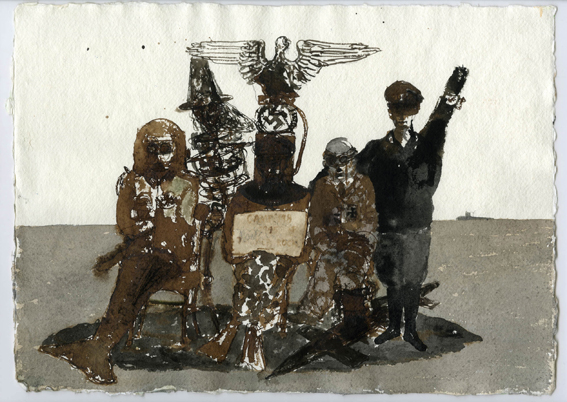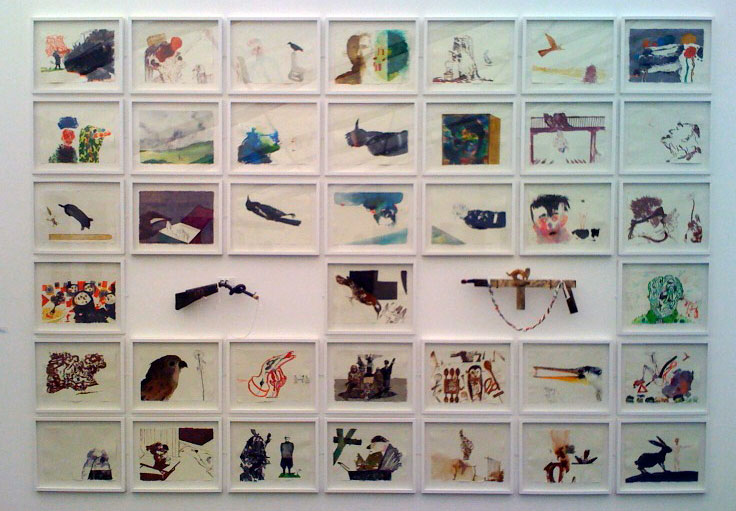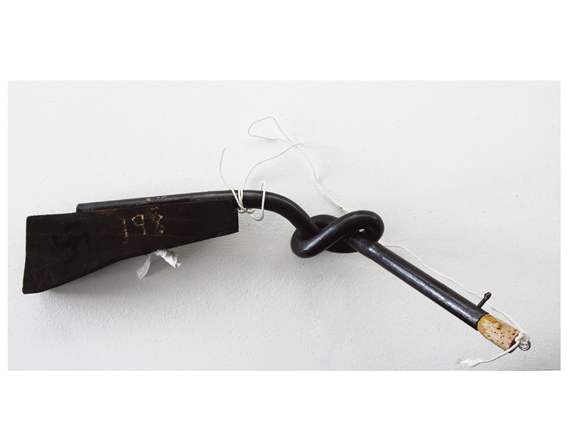Unfamiliar Stories from Memory
David Greenslade profiles the artist David Rees Davies whose work is being exhibited at the National Eisteddfod 2009
30.07.09
Parataxis is a formidable and popular trope among contemporary poets. In writing, it involves the omission of conjunctions that might ease an often severe juxtaposition of images. Literature made this way frequently results in texts that are dense with meaning or crammed with disrupted meanings that collide and fragment according to material (linguistic) decisions as much as intentions of vision or utterance.
David Rees Davies grew up in Bridgend and currently works at Kingston University, London. He is a visual artist, a painter and sculptor whose representational style within his graphic works – especially the drawings – omits the usual signals of narrative explanation while clearly displaying what looks like the classic conventions of accomplished drawing. His work is locally informed, devoted to Mid-Glamorgan, and parataxis is just one of the rhetorical devices he uses when assembling a picture.
Davies’s series entitled Crack Hill (an accident-prone stretch of the A48 between Bridgend and Cardiff) is a series of ludic explorations of the meaning of "crack", "shatter", "riddle", "rake", "reform" and "recombine". Davies’s father was a gamekeeper on the Tythegston Estate in south Wales, and the natural and human landscapes of Crack Hill, Merthyr Mawr, Llanharan Colliery (closed 1962) as well as the seascapes of Tusker Rock and the Bristol Channel all find their way into the work.

Tusker Rock by David Rees Davies. (Photo courtesy of David Rees Davies.)
One of Davies's drawings has been chosen for this year's prestigious Jerwood Drawing Prize Touring Exhibition. Visual communication remains important to his work, and he calls many of his pictures "stories". A large forty-piece installation at this year's Bala Eisteddfod has the title "From Brynna to Merthyr Mawr and Other Stories". But visual storytelling works differently from writing and Davies prioritises impact and juxtaposition – especially across time – over the obligations of explanations.
As we look at a David Rees Davies work on paper or on canvas we recognise individual and clustered units of imagery; we may recognise intuitive transitions in mass or line from one part of a drawing to another. Suddenly, however, we realise that we cannot quite follow how a hare stained with RAF chevrons, pierced by an arrow, finds itself alongside a meticulously drawn inverted fire bucket running away in stockinged legs from a melancholy Nazi colonel holding a stick of Porthcawl rock.

David Rees Davies's exhibition at the 2009 Bala Eisteddfod. (Photo courtesy of David Rees Davies.)
For Davies, recall is a fundamental aspect of his art. His work issues from memory and is modestly presented as only his part of larger community memory: access to the past is never fully possible or intended. Associations of graphic intensity and immediate recognition deflect other discursive elements normally associated with representation such as context and visual disambiguation. While the images are not graphically ambiguous, their assembly is radically disjointed in time, tone and scale. They also confound other devices such as fidelity, logic and boundary. When the identity of an image does become uncertain it is never vague. Figures whose bodies start unravelling or merging from human to animal or object to human do so clearly and crisply in lines sprung with tension or suddenly diffuse with all the impact of a breach between one order of existence and another.
It was Henri Bergson who, in the same way that Freud "discovered" the modern unconscious, "discovered" that memory isn't just a psychic phenomenon but that it has material properties as well. Memory influences perception not only of present things but of the past and future also. Bergson goes as far as to say that memory constitutes the material world.
Nostalgia can be an interfering vigilante when it comes to memory, seeking to lock up what emerges back there in a reduced, sentimental form. Fortunately Davies Rees Davies's practice displays keen, rigorous standards of uncensored recall, selection and depiction. Sentiment when admitted fully and with maturity is much more than "the tender emotions" and is also wary of Romantic calls to individual grandeur or collective feeling.
 Knot-Gun by David Rees Davies. (Photo courtesy of David Rees Davies.)
Knot-Gun by David Rees Davies. (Photo courtesy of David Rees Davies.)
By including portraits of Nazi officers at Island Farm Prisoner of War Camp No. 198, which existed at Bridgend from 1945 until 1948, David Rees Davies reminds us sharply that the past and memories of the past include as many horizons of horror and joy as the present and any future that memory makes possible. Prisoners at Island Farm beat one of their fellow officers to death when he refused to sign a card for Hitler’s birthday. Images in David Rees Davies’s repertoire flip between the dark and the bright with unexpected speed.
David Greenslade